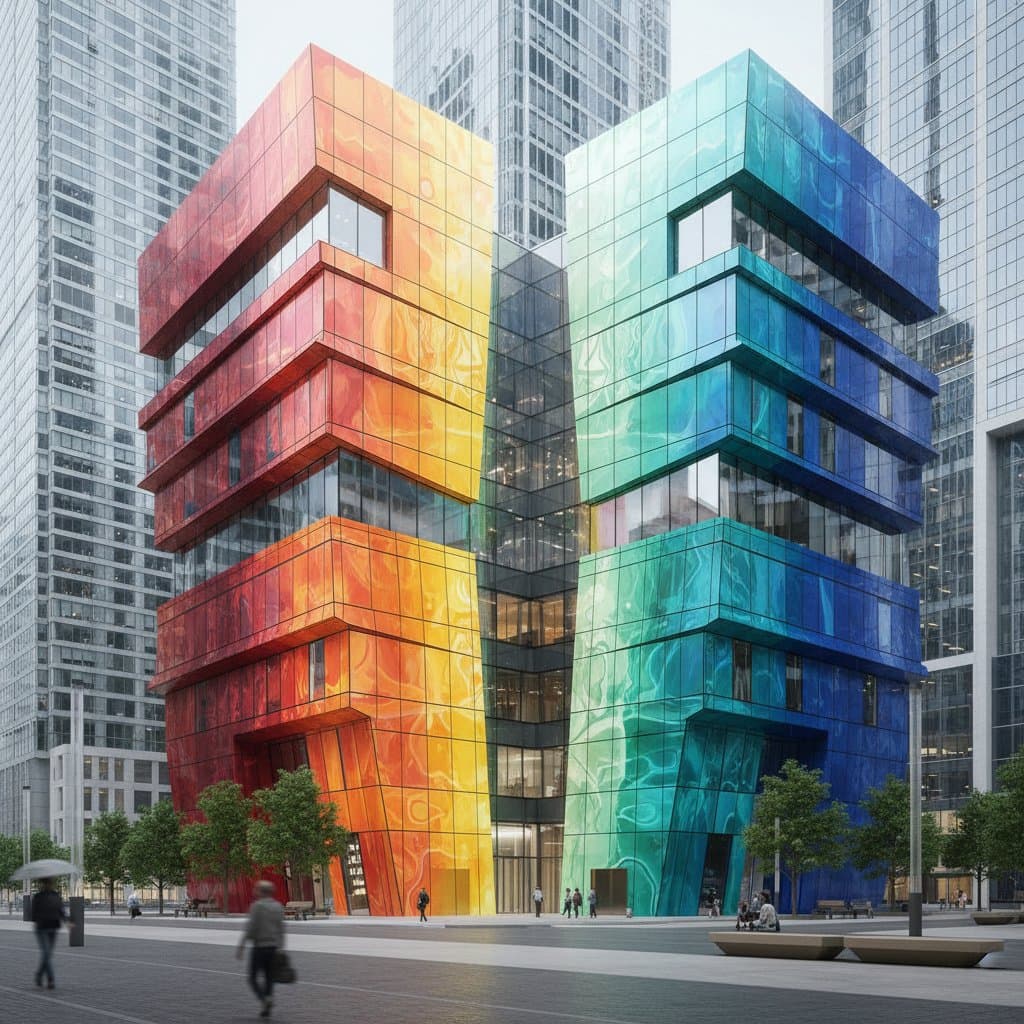Why Color-Changing Facades Transform Architecture
Picture a building facade that alters its hue as sunlight shifts across the sky or as observers change their vantage point. This surface responds to environmental cues, creating an illusion of vitality. Such innovation captivates passersby and invites closer examination of the underlying technology.
Architects integrate these dynamic elements to produce structures that engage with natural forces like light, temperature, and moisture. Beyond mere visual appeal, this technology enhances energy management, prolongs material durability, and minimizes upkeep demands for property owners and developers.
Key Distinctions of Color-Changing Facades
Color-changing facades employ specialized materials that modify their visual properties in response to external stimuli, including light incidence, thermal variations, or atmospheric humidity. Common options encompass interference coatings, thermochromic films, and iridescent alloys. In contrast to conventional static paints, these solutions generate fluid tonal transitions without any motorized components.
This adaptability fosters a seamless integration between the building and its locale, from high-rise complexes to contemporary residences. Structures gain prominence through inherent dynamism rather than elaborate motifs or embellishments. In communities that prioritize progressive yet understated aesthetics, this equilibrium proves particularly suitable.
Mechanisms Driving the Technology
The principles governing color-changing facades rely on precise manipulation of light interaction at the material surface. Coatings selectively reflect particular light wavelengths, and alterations in observation angle or illumination intensity prompt corresponding color variations.
Three primary techniques dominate the field:
- Interference Coatings: Composed of ultra-thin, multilayered films, these mimic the prismatic effects observed in phenomena like oil slicks on water, yielding iridescent shifts.
- Thermochromic Materials: Sensitive to heat fluctuations, they transition from one shade to another; for instance, a facade might display indigo under cooler temperatures before evolving to a metallic sheen upon warming.
- Photochromic Finishes: Activated by ultraviolet exposure, these adapt opacity to control light penetration, thereby mitigating excessive brightness and heat buildup.
Implementation costs vary by method. Interference coatings generally range from 15 to 25 dollars per square foot, inclusive of materials and basic application. Thermochromic films fall between 10 and 18 dollars per square foot under similar terms. These estimates exclude preparatory work such as substrate priming or access equipment.
Performance Benefits Extending Past Visual Impact
These facades deliver functional advantages that support operational efficiency and endurance.
Enhanced Energy Management
Certain formulations dynamically regulate thermal absorption and reflection. By adapting to solar conditions, they alleviate demands on HVAC systems, potentially lowering electricity consumption by up to 15 percent in sun-exposed regions.
Superior Ultraviolet Resistance
Integrated barriers shield underlying substrates from degrading UV radiation, which otherwise accelerates discoloration and structural wear. This feature can extend the service life of adjacent elements by several years.
Reduced Upkeep Requirements
The inherent variability in appearance masks subtle imperfections from environmental exposure, such as light patina or inconsistencies. Property managers thus schedule major interventions less frequently, saving on labor and materials.
Expanded Creative Opportunities
Designers realize striking effects through material properties alone, bypassing the need for intricate geometries or superfluous detailing. This approach aligns well with eco-conscious paradigms emphasizing simplicity and resource conservation.
Practical Hurdles and Strategic Planning
Adopting color-changing facades involves navigating technical and regulatory obstacles to ensure long-term viability.
Application Demands
Precise environmental controls during installation prevent defects like patchy coloration or diminished responsiveness. For expansive surfaces, engage certified facade technicians who specialize in climate-regulated processes and quality assurance protocols.
Longevity Factors
While formulated for exterior durability, contaminants such as urban pollutants or coastal aerosols may gradually impair vibrancy. Implement quarterly rinsing with mild solutions and yearly professional assessments to sustain optimal condition.
Regulatory Compliance
Local authorities often oversee aesthetic modifications through review panels. Verify alignment with zoning stipulations on reflective surfaces or color variance prior to procurement, potentially requiring preliminary mockups for approval.
Financial Analysis
Initial expenditures surpass traditional options by 20 to 40 percent, yet amortized savings from efficiency gains and deferred maintenance often recoup investments within five to seven years. In retail or office settings, the distinctive allure can elevate occupancy rates and attract clientele.
Steps for Initiating a Facade Upgrade
Prospective adopters begin by prototyping on a modest scale. Select an inconspicuous area, such as a side elevation, to apply the chosen material and monitor diurnal light interactions over weeks. Positive outcomes justify broader implementation.
When selecting installers, prioritize portfolios demonstrating proficiency in advanced coatings. Solicit case studies of comparable projects and clarify terms for warranties encompassing defects in adhesion or color fidelity. Factor in timelines for surface curing, which may span days to weeks depending on ambient conditions.
Sustaining Facade Performance
Routine care preserves the sophisticated optics at play. Quarterly cleaning with pressurized water and pH-neutral cleaners eliminates accumulations that obscure shifts. Steer clear of harsh abrasives that could etch protective layers.
Annual evaluations of perimeter seals guard against water intrusion, which undermines substrate integrity. In harsh environments marked by intense insolation or saline mists, renew a transparent overcoat every three to five years to reinforce resilience.
Integrating Responsiveness into Architectural Practice
Advancements in material science democratize access to color-changing facades, extending their application from iconic edifices to routine constructions.
Opt for iridescent subtlety or thermochromic drama to craft edifices that harmonize with temporal and seasonal rhythms. This integration not only elevates aesthetic presence but also embodies forward-thinking stewardship of built environments.
